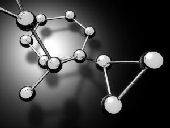
Purpose
To create fun, colorful, and delicious molecule structures out of candy, such as H20 and CO2 molecules.
Additional information
Molecules are made up of at least two atoms in a definite arrangement and held together by a chemical bond. The science of molecules is known as molecular chemistry, dealing with the laws exercising control over the interaction between molecules that results in alteration of chemical bonds. Molecules may be made up of atoms in the same chemical element, such as Oxygen (O2) or water (H2O).
Sponsored Links
Required materials
- Toothpicks
- Gum drop candy of various colors. The candy simply named "drops" works very well as their just the right size for the experiment.
- Bowl
Estimated Experiment Time
About 10 minutes or less.
Step-By-Step Procedure
- 1. Assign each gum-drop candy to an atom based on color. For example, red = hydrogen, green = carbon, and yellow = oxygen. You may want to write down your atom to color assignments on paper so easily remember them.
- 2. Make a water molecule (the famous H2O). Water molecules are made up of two hydrogen atoms that are joined to one oxygen atom inside water. So, join two hydrogen (red) pieces of candy to one oxygen (yellow) piece of candy with toothpicks. Put your molecule into your bowl. Make several more H20 molecules and place them in the bowl.
- 3. Now make a carbon dioxide molecule (C02). Carbon dioxide molecules are made up of two oxygen atoms joined to one carbon atom. So, join two oxygen (yellow) pieces of candy to one carbon (green) piece of candy with the toothpicks. Make several more C02 molecules and place them in the bowl.
- 4. When you're ready, reach into the bowl and select a molecule. Can you identify it? After it's been identified, you can eat your molecule (be sure to remove the toothpicks first)!
- 5. Want to create more tasty molecules? See the following chart for examples of other molecules you can try to make!
| Molecule |
Designation |
| C2H |
Ethynyl radical |
| C2O |
Dicarbon monoxide |
| H2C |
Methylene |
| C3O |
Tricarbon monoxide |
| H2CO |
Formaldehyde |
| HCOOH |
Formic acid |
| CH3OH |
Methanol |
| CH3C2H |
Methylacetylene |
| H2COHCHO |
Glycolaldehyde |
| CH3OC2H5 |
Trans-ethyl methyl ether |
Note
Any gummy drop candy will work for this experiment as long as their are several colors available. If you don't have the colors described in the project, you can just assign different atoms based on the colors you have available.
Observation
What other molecules can you make from your gummy candy drops? Try making several other molecules of varying complexity in the same manner described in the project. Add them to the bowl and try to identify the molecules as you pull them out (you may need to get a bigger bowl). Can you successfully guess your molecules with 100% accuracy?
Result
The candy is a fun way to construct our own models of molecules from different colored "atoms". Water (H20) is the most important liquid on earth. Carbon dioxide (CO2) is the gas we breathe out. There are more than 100 different atoms, so you would need an array of 100 different colors of candies to make every possible molecule.
Sponsored Links
Take a moment to visit our table of Periodic Elements page where you can get an in-depth view of all the elements,
complete with the industry first side-by-side element comparisons!